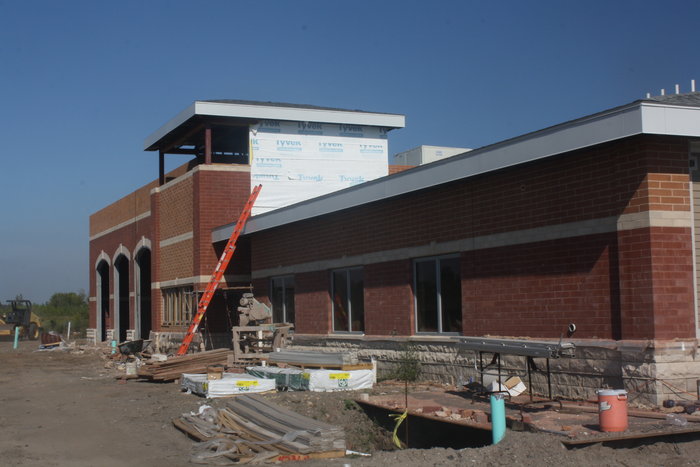Just as the city seems poised to see continued upscale redevelopment at the former Military Ocean Terminal (MOTBY), the newest fire station is poised to open.
“We’re hoping to see the new fire station open before the end of the year,” said Fire Chief Greg Rogers.
After some delay due to bidding issues, the new firehouse broke ground in August, 2012, funded by a $3.56 million federal grant from the Assistance to Firefighters Fire Station Construction Grants program. It is one of $380 million in grants funded by the American Recovery and Reinvestment Act (ARRA) to pay for fire-station construction, as well as port and transit security initiatives nationwide.
Bayonne is the only fire department in the state to receive this grant, the sixth largest to be awarded to any municipality in the nation. The new firehouse is replacing the tent that the department currently uses to house fire vehicles servicing the Route 440 area.
With work continuing steadily for more than a year, the firehouse is nearly completed and is expected to house two fire companies, covering the east side of Bayonne as well as providing coverage in other parts of the city when necessary.
When the Peninsula was still in operation as a military base, the U.S. Army maintained its own fire department and built a firehouse there. When the federal government closed the base in 1999, Bayonne took over the fire service. But the sale of the land forced the fire department to relocate. This coincided with a report by Matrix Consultants in December 2007 that recommended combining several operating departments at one location.
The new firehouse replaces two houses that the department formerly used, one built in 1888 and the other in 1939.
Since the 34th Street Station was only seven blocks from another station, it was moved to provide more rapid response and wider coverage from the new location, which has immediate access to 34th Street, as well as to Route 440 and roads leading into the Peninsula at Bayonne Harbor.
The 5,000-square-foot tent was installed at the edge of the Peninsula to temporarily house the units until a new state-of-the art facility could be constructed. The city’s master plan calls for a new permanent structure to house the fire department located in the Harbor Station South area.
In the depressed local and national economy, the city had to find ways to fund the new building so that the fire companies can be moved out of the tent and the firefighters moved out of the adjacent trailers they currently use as residences.
New firehouse comes with new development
The firehouse opening will come at an opportune time, local officials said, noting that the proposal by Royal Caribbean to build a permanent and upscale cruise port center on the former Military Ocean Terminal will likely see resurgence in commercial and residential development in the area. This coincides with the settlement of a lawsuit with developers for the nearby Harbor Station North development district, and will likely result on construction of residential housing there in the near future. The city is also expected to announce plans for a new hotel in the Harbor Station South section, a possible anchor for future retail, commercial, and residential development on other sections of MOTBY.
Last year, Rep. Albio Sires said he and U.S. Senator Robert Menendez had made the case in Congress for the new firehouse, citing its proximity to New York and the threat posed to this stretch of harbor that the FBI once identified as the two most dangerous miles in America. The section includes the Holland Tunnel, Global Terminal cargo port, and chemical storage tanks.
Since the new firehouse will also serve as a training facility and a decontamination center, and its firefighters will respond to any threat along the eastern side of Bayonne and beyond, Congress agreed, Sires said.
“This is another step at securing the area,” Sires said.
Rogers, who oversaw the planning and construction of the temporary tent firehouse, said he was also involved in the planning for the new station.
“The temporary firehouse is not very accommodating,” Rogers said, noting the tent and its trailers housed a rotation of 12 to 16 firefighters every four days, all of whom had to live in cramped trailers and work in a moisture-filled tent.
Al Sullivan may be reached at asullivan@hudsonreporter.com.
